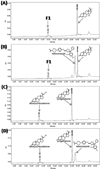Synthesis of halogenated pregnanes, mechanistic probes of steroid hydroxylases CYP17A1 and CYP21A2
- PMID: 22001566
- PMCID: PMC3306177
- DOI: 10.1016/j.jsbmb.2011.09.007
Synthesis of halogenated pregnanes, mechanistic probes of steroid hydroxylases CYP17A1 and CYP21A2
Abstract
The human steroidogenic cytochromes P450 CYP17A1 (P450c17, 17α-hydroxylase/17,20-lyase) and CYP21A2 (P450c21, 21-hydroxylase) are required for the biosynthesis of androgens, glucocorticoids, and mineralocorticoids. Both enzymes hydroxylate progesterone at adjacent, distal carbon atoms and show limited tolerance for substrate modification. Halogenated substrate analogs have been employed for many years to probe cytochrome P450 catalysis and to block sites of reactivity, particularly for potential drugs. Consequently, we developed efficient synthetic approaches to introducing one or more halogen atom to the 17- and 21-positions of progesterone and pregnenolone. In particular, novel 21,21,21-tribromoprogesterone and 21,21,21-trichloroprogesterone were synthesized using the nucleophilic addition of either bromoform or chloroform anion onto an aldehyde precursor as the key step to introduce the trihalomethyl moieties. When incubated with microsomes from yeast expressing human CYP21A2 or CYP17A1 with P450-oxidoreductase, CYP21A2 metabolized 17-fluoroprogesterone to a single product, whereas incubations with CYP17A1 gave no products. Halogenated steroids provide a robust system for exploring the substrate tolerance and catalytic plasticity of human steroid hydroxylases.
Copyright © 2011 Elsevier Ltd. All rights reserved.
Figures









Similar articles
-
Effects of fluorine substitution on substrate conversion by cytochromes P450 17A1 and 21A2.Org Biomol Chem. 2021 Sep 15;19(35):7664-7669. doi: 10.1039/d1ob01178b. Org Biomol Chem. 2021. PMID: 34524336 Free PMC article.
-
Minor activities and transition state properties of the human steroid hydroxylases cytochromes P450c17 and P450c21, from reactions observed with deuterium-labeled substrates.Biochemistry. 2012 Sep 11;51(36):7064-77. doi: 10.1021/bi300895w. Epub 2012 Aug 27. Biochemistry. 2012. PMID: 22873692 Free PMC article.
-
Epoxidation activities of human cytochromes P450c17 and P450c21.Biochemistry. 2014 Dec 9;53(48):7531-40. doi: 10.1021/bi5011865. Epub 2014 Nov 25. Biochemistry. 2014. PMID: 25386927 Free PMC article.
-
The diverse chemistry of cytochrome P450 17A1 (P450c17, CYP17A1).J Steroid Biochem Mol Biol. 2015 Jul;151:52-65. doi: 10.1016/j.jsbmb.2014.11.026. Epub 2014 Dec 4. J Steroid Biochem Mol Biol. 2015. PMID: 25482340 Free PMC article. Review.
-
Structural insights into the function of steroidogenic cytochrome P450 17A1.Mol Cell Endocrinol. 2017 Feb 5;441:68-75. doi: 10.1016/j.mce.2016.08.035. Epub 2016 Aug 24. Mol Cell Endocrinol. 2017. PMID: 27566228 Free PMC article. Review.
Cited by
-
Effects of fluorine substitution on substrate conversion by cytochromes P450 17A1 and 21A2.Org Biomol Chem. 2021 Sep 15;19(35):7664-7669. doi: 10.1039/d1ob01178b. Org Biomol Chem. 2021. PMID: 34524336 Free PMC article.
-
Minor activities and transition state properties of the human steroid hydroxylases cytochromes P450c17 and P450c21, from reactions observed with deuterium-labeled substrates.Biochemistry. 2012 Sep 11;51(36):7064-77. doi: 10.1021/bi300895w. Epub 2012 Aug 27. Biochemistry. 2012. PMID: 22873692 Free PMC article.
-
Human cytochrome P450 enzymes 5-51 as targets of drugs and natural and environmental compounds: mechanisms, induction, and inhibition - toxic effects and benefits.Drug Metab Rev. 2018 Aug;50(3):256-342. doi: 10.1080/03602532.2018.1483401. Drug Metab Rev. 2018. PMID: 30717606 Free PMC article. Review.
-
Epoxidation activities of human cytochromes P450c17 and P450c21.Biochemistry. 2014 Dec 9;53(48):7531-40. doi: 10.1021/bi5011865. Epub 2014 Nov 25. Biochemistry. 2014. PMID: 25386927 Free PMC article.
References
-
- Therrell BLJ, Berenbaum SA, Manter-Kapanke V, Simmank J, Korman K, Prentice L, Gonzalez J, Gunn S. Results of screening 1.9 million Texas newborns for 21-hydroxylase-deficient congenital adrenal hyperplasia. Pediatrics. 1998;101:583–590. - PubMed
-
- Costa-Santos M, Kater CE, Auchus RJ. Two prevalent CYP17 mutations and genotype-phenotype correlations in 24 Brazilian patients with 17-hydroxylase deficiency. J Clin Endocrinol Metab. 2004;89:49–60. - PubMed
-
- Newton-Cheh C, Johnson T, Gateva V, Tobin MD, Bochud M, Coin L, Najjar SS, Zhao JH, Heath SC, Eyheramendy S, Papadakis K, Voight BF, Scott LJ, Zhang F, Farrall M, Tanaka T, Wallace C, Chambers JC, Khaw KT, Nilsson P, van der Harst P, Polidoro S, Grobbee DE, Onland-Moret NC, Bots ML, Wain LV, Elliott KS, Teumer A, Luan J, Lucas G, Kuusisto J, Burton PR, Hadley D, McArdle WL, Brown M, Dominiczak A, Newhouse SJ, Samani NJ, Webster J, Zeggini E, Beckmann JS, Bergmann S, Lim N, Song K, Vollenweider P, Waeber G, Waterworth DM, Yuan X, Groop L, Orho-Melander M, Allione A, Di Gregorio A, Guarrera S, Panico S, Ricceri F, Romanazzi V, Sacerdote C, Vineis P, Barroso I, Sandhu MS, Luben RN, Crawford GJ, Jousilahti P, Perola M, Boehnke M, Bonnycastle LL, Collins FS, Jackson AU, Mohlke KL, Stringham HM, Valle TT, Willer CJ, Bergman RN, Morken MA, Doring A, Gieger C, Illig T, Meitinger T, Org E, Pfeufer A, Wichmann HE, Kathiresan S, Marrugat J, O'Donnell CJ, Schwartz SM, Siscovick DS, Subirana I, Freimer NB, Hartikainen AL, McCarthy MI, O'Reilly PF, Peltonen L, Pouta A, de Jong PE, Snieder H, van Gilst WH, Clarke R, Goel A, Hamsten A, Peden JF, Seedorf U, Syvanen AC, Tognoni G, Lakatta EG, Sanna S, Scheet P, Schlessinger D, Scuteri A, Dorr M, Ernst F, Felix SB, Homuth G, Lorbeer R, Reffelmann T, Rettig R, Volker U, Galan P, Gut IG, Hercberg S, Lathrop GM, Zelenika D, Deloukas P, Soranzo N, Williams FM, Zhai G, Salomaa V, Laakso M, Elosua R, Forouhi NG, Volzke H, Uiterwaal CS, van der Schouw YT, Numans ME, Matullo G, Navis G, Berglund G, Bingham SA, Kooner JS, Connell JM, Bandinelli S, Ferrucci L, Watkins H, Spector TD, Tuomilehto J, Altshuler D, Strachan DP, Laan M, Meneton P, Wareham NJ, Uda M, Jarvelin MR, Mooser V, Melander O, Loos RJ, Elliott P, Abecasis GR, Caulfield M, Munroe PB. Genome-wide association study identifies eight loci associated with blood pressure. Nat Genet. 2009;41:666–676. - PMC - PubMed
-
- Attard G, Reid AH, Yap TA, Raynaud F, Dowsett M, Settatree S, Barrett M, Parker C, Martins V, Folkerd E, Clark J, Cooper CS, Kaye SB, Dearnaley D, Lee G, de Bono JS. Phase I clinical trial of a selective inhibitor of CYP17, abiraterone acetate, confirms that castration-resistant prostate cancer commonly remains hormone driven. J Clin Oncol. 2008;26:463–4571. - PubMed
Publication types
MeSH terms
Substances
Grants and funding
LinkOut - more resources
Full Text Sources

